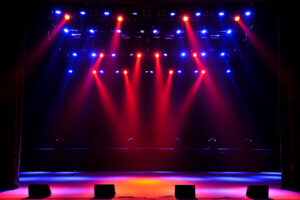Stage lighting is an unsung hero of theatrical productions, concerts, and events. While the audience often marvels at the actors’ performances, the set design, and the music, the lighting is the subtle brush that paints the scene, setting the mood, directing focus, and transforming a simple stage into a vivid, emotional canvas. This article explores the intricate art of stage lighting, delving into its principles, techniques, and the creativity it demands.
theatrical productions, concerts, and events. While the audience often marvels at the actors’ performances, the set design, and the music, the lighting is the subtle brush that paints the scene, setting the mood, directing focus, and transforming a simple stage into a vivid, emotional canvas. This article explores the intricate art of stage lighting, delving into its principles, techniques, and the creativity it demands.
The Role of Stage Lighting
Stage lighting serves multiple purposes, each vital to the success of a production:
- Illumination: At its core, lighting ensures the audience can see the performers and the stage.
- Mood and Atmosphere: Different colors, intensities, and lighting angles evoke emotions, from the warmth of a sunset to the foreboding shadows of a suspenseful scene.
- Focus and Direction: Lightning guides the audience’s attention by highlighting specific areas or characters.
- Time and Place: Lighting can simulate time of day, weather conditions, and geographical settings.
- Aesthetic Composition: Lights enhance the stage’s visual appeal, complementing costumes, props, and set design.
The Palette of a Lighting Designer
Much like a painter selects colors and brushes, a lighting designer chooses tools and techniques to bring their vision to life. Key components of their palette include:
1. Types of Lights
- Spotlights: Focused beams used to highlight individuals or specific areas.
- Floodlights: Broad lights are used to illuminate large areas.
- LEDs: Versatile lights capable of producing a wide spectrum of colors.
- Moving Lights: Automated fixtures that can change position, color, and intensity during a performance.
2. Lighting Angles
- Front Lighting: Illuminates the subject directly, reducing shadows.
- Side Lighting: Adds depth and dimension to the subject.
- Back Lighting: This creates a silhouette effect or separates the subject from the background.
- Top and Under Lighting: Enhances dramatic effects by casting unique shadows.
3. Color
The psychological impact of color is profound. Warm tones like red and yellow evoke passion or joy, while cool tones like blue and green can convey calm or melancholy. Gels, filters, and LED programming allow for an infinite range of hues.
4. Intensity and Texture
Adjusting the brightness and using gobos (templates placed in front of a light source) can add texture, creating patterns like leaves, grids, or abstract shapes.
The Design Process
A lighting designer begins by collaborating closely with the director, set designer, and costume designer. Understanding the production’s themes, mood, and logistical needs is crucial. The process typically involves:
- Script Analysis: Identifying moments that require specific lighting effects.
- Visual Research: Gathering inspiration from art, photography, and real-world settings.
- Plotting the Design: Creating a lighting plot—a detailed map of where each light will be positioned and its intended effect.
- Programming: Using advanced lighting consoles to pre-set cues for seamless transitions during the performance.
- Rehearsals: Fine-tuning the lighting in collaboration with the cast and crew.
The Science Behind the Art
While creativity drives the design, technical expertise anchors it. Designers must understand the physics of light, such as reflection, refraction, and diffusion. Additionally, they work with complex technologies, including DMX control systems, dimmers, and software like Vectorworks and Lightwright.
Challenges and Rewards
Stage lighting is not without its challenges. Designers often work under tight deadlines, manage budgets, and navigate unexpected technical issues. However, the reward lies in the transformative power of their craft. The moment the house lights dim and their design comes to life, the audience is transported—immersed in a world where light and shadow tell a story as eloquently as words and music.
More Than An Accessory
Stage lighting is more than an accessory to a production; it is an art form that breathes life into the stage. By skillfully combining light and shadow, color and intensity, creativity and science, lighting designers craft experiences that linger in audiences’ hearts and minds. The next time you attend a performance, take a moment to appreciate the light—the invisible hand that paints the scene.
